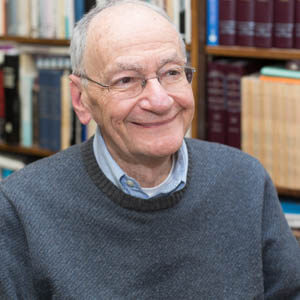
What Our Clothes Can Do For Us
Feb 12, 2011 By Andrew Shugerman | Commentary | Text Study | Tetzavveh
I recall first grasping the wise adage that “the clothes make the man” in a dressing room at the Kennedy Center between acts of the Washington Opera’s production of Rimsky-Korsakov’s The Tsar’s Bride. After performing as a peasant child in the chorus, I needed to change quickly into the opulent regal attire for my other role as Tsareyvitch — the tsar’s son. Exchanging my drab brown clothing for a multicolored outfit of silk, sequins, and rhinestones completely shifted my sense of self and purpose.
Read More
Four Special Sabbaths
Feb 19, 1994 By Ismar Schorsch | Commentary | Shabbat Zakhor | Tetzavveh | Pesah
Judaism does not allow Passover to catch us by surprise. Long before its arrival, while the ground is still covered with snow, the Jewish calendar alerts us to its coming. A series of four special sabbaths prior to the month of Nisan (Passover begins on the full moon of the 15th of Nisan) picks up the liturgical pace of the synagogue service. After a long and largely monotonous winter, the pace quickens as we are brought to anticipate the renewal of nature and the redemption of Israel. In the words of our tradition, “With the coming of Adar (the month before Nisan), we indulge in more merrymaking.” The last month of the year (Nisan is the first) goes out in a flurry of festivity which transcends the celebration of Purim.
Read More
The Clothes Make the Man
Feb 19, 2016 By Rachel Smith | Commentary | Tetzavveh
Read More[The] unlikely alliance of diverse and superficially incompatible musical traditions, mysteriously accomplished under punk, found ratification in an equally eclectic clothing style which reproduced the same kind of cacophony on the visual level.
—Dick Hebdige, Subculture: The Meaning of Style, 26

Garments of Light
Feb 12, 2016 By Raymond Scheindlin | Commentary | Tetzavveh
Last week, we read God’s orders to Moses for the construction of the Tabernacle and its accoutrements. This week, our parashah continues on the subject of the Tabernacle and the preparations for starting the sacrificial cult, focusing on the Tabernacle’s personnel: the priests—particularly their vestments and the rituals for the priests’ consecration. These subjects will return, for after a week devoted largely to the story of the Golden Calf, the Torah will repeat the account of the Tabernacle nearly verbatim, not in the form of instructions for things to be made but as a narrative of their making.
Read More
Holy Light: Remembering Sara Duker and Matthew Eisenfeld
Feb 22, 1997 By Ismar Schorsch | Commentary | Tetzavveh
This past week at the Seminary, we commemorated the first Yahrzeit of Sara Duker and Matthew Eisenfeld, whose young lives were extinguished one year ago (February 25, 1996) in Jerusalem by the bomb of a Hamas terrorist. Matthew was a second–year rabbinical student spending the year studying intensively at the Seminary’s Beit Midrash, and Sara, who had just graduated Barnard, was about to become his fiancee. We used the occasion of their Yahrzeit to dedicate in their memory a spacious room where Seminary students gather each day till late at night to study Talmud in small groups, havruta–style.
Read More
Clothing Without and Within
Mar 3, 2007 By Matthew Berkowitz | Commentary | Tetzavveh | Purim
Clothing offers keen insight in two complementary directions. First, the raiment one wears reveals one’s personality. While a neat, well fitting suit may convey a sense of professionalism and conservatism, jeans and a tie-dyed shirt reflect a casual, relaxed, and liberal sense of self. And just as clothing offers an allusion inward, so, too, does it give us a sense of what is transpiring around us. A kittel (a white ritual robe worn at liminal moments) or tallit (prayer shawl) signals a moment of prayerful reflection; tuxedos and gowns tip us off to a wedding reception; and black garments often represent mourning. Thus, clothing is a mark of the internal as well as the external.
Read More
The Sound of a Guest
Mar 6, 2004 By Melissa Crespy | Commentary | Tetzavveh
I am continually amazed at how the Rabbis of ancient times were able to make even seemingly obscure passages in the Torah relevant to their times – and ours. Our parashah this week is full of details, details about the clothing and ornaments of the priests and of their ordination. And while the Rabbis of ancient times may have longed for a rebuilding of the Temple – with all its consequent religious, national and political significance – in their day it was no longer standing, and its priests were no longer functioning. What then, to make of the sections of the Torah dealing with the priests’ garments?
Read More
Flames That Ascend on Their Own
Feb 23, 2002 By Melissa Crespy | Commentary | Tetzavveh
The Rabbis, ever careful readers of the Torah text, noticed an oddity in the first verse of our parashah. In describing how olive oil shall be brought to light the menorah — the seven—branched lampstand which stood in the Sanctuary — the Torah says: “You shall further instruct the Israelites to bring you [v’yikhu aylekha] clear oil of beaten olives for lighting, for kindling lamps regularly.” Shouldn’t the text say “instruct the Israelites to bring Me …” This was, after all, to be the Sanctuary where the Israelites felt the Divine Presence.
Read More


